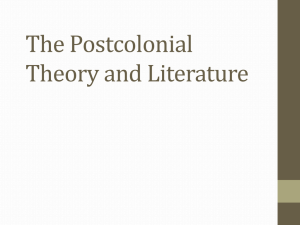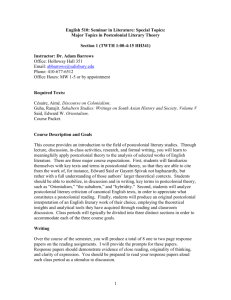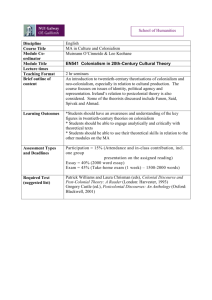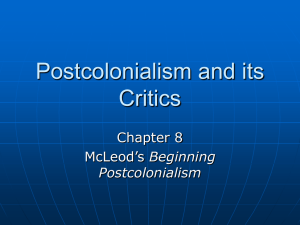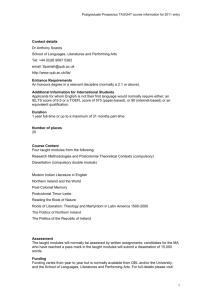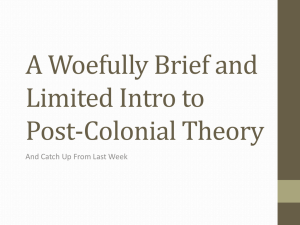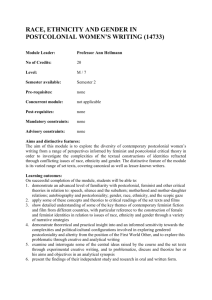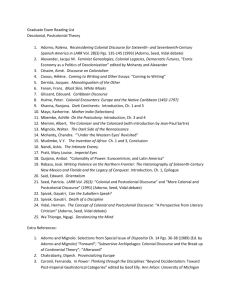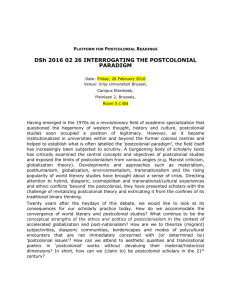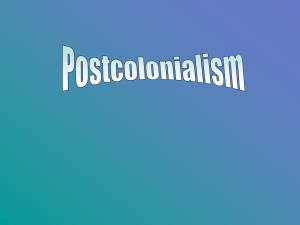the apollonian - WordPress.com
advertisement
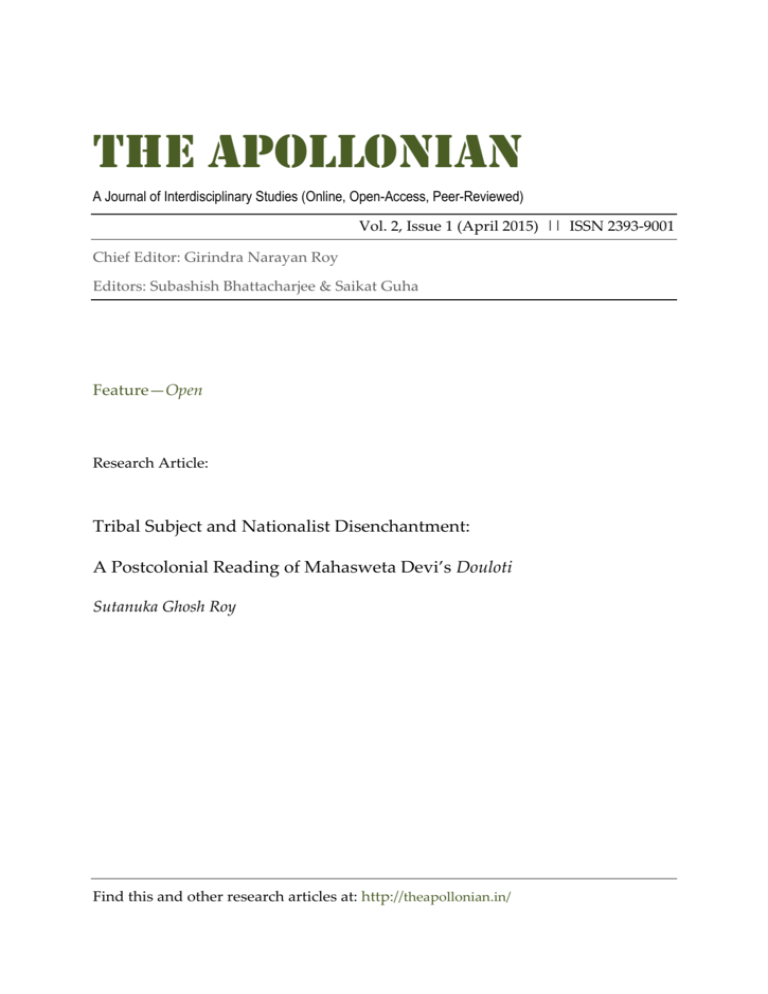
THE APOLLONIAN A Journal of Interdisciplinary Studies (Online, Open-Access, Peer-Reviewed) Vol. 2, Issue 1 (April 2015) || ISSN 2393-9001 Chief Editor: Girindra Narayan Roy Editors: Subashish Bhattacharjee & Saikat Guha Feature—Open Research Article: Tribal Subject and Nationalist Disenchantment: A Postcolonial Reading of Mahasweta Devi’s Douloti Sutanuka Ghosh Roy Find this and other research articles at: http://theapollonian.in/ The Apollonian 2.1 (April 2015) 121 Tribal Subject and Nationalist Disenchantment: A Postcolonial Reading of Mahasweta Devi’s Douloti Sutanuka Ghosh Roy Tarakeswar Degree College, University of Burdwan, India More than three-quarters of people living in today’s world in one way or other have had their lives shaped by the experience of colonialism. Postcolonial literature offers one of the credible ways in which these new perspectives are expressed. It is in the writings of the postcolonial authors that the day-to-day realities experienced by colonized people have been most powerfully encoded and remain profoundly influential. While identifying the characteristic features of postcolonial literature, Promod Nayar notes that, anti-colonial literature ‘thematis*e+ the problems of colonialism *,+ *<+ captur*e+ the cultural and social impact of colonial rule in native, non-Western societies [,] [..] [are] interested in the ways in which native societies responded to Western cultural presence, [..] [and are] essentially case studies of cultural colonialism, native identity, and anti-colonial resistance’ (36). In the late 1970s and early 1980s postcolonialism comes into the foreground as a critical concept. However, one can trace the roots of postcolonial thinking in the 19th century itself. Even in the postcolonial readings of this century there lies a clear demarcation between the ‘Western countries’ and ‘other countries’. In the 19th century the colonial expansion covered almost ‘nine-tenths of the entire land surface of the globe’ (Young 2). Various European anthropologists endorsed the Westerns as a superior race. The rest of the third world people were considered ‘inferior’, the ‘other’: Colonial and imperial rule was legitimized by anthropological theories which increasingly portrayed the peoples of the colonized world as inferior, childlike, or feminine, incapable of looking after themselves (despite having done so perfectly well for millennia) and requiring the paternal rule of the West for their own best interests (today they are deemed to require ‘development’). (Young 2) The Apollonian 2.1 (April 2015) 122 Even when most of the colonies achieved political independence in the twentieth century, a process of ‘othering’ is inherent in the structure of thought. The outcome is expressed in a chain of oppositions such as Europe and ‘others’. This again is a world hegemonised by the first terms in the oppositional sets. We are to remember that hegemony presupposes repression of ‘others’. As a consequence the paternal (read West) voice silences ‘other’ voices. One enters into a kind of temporality that subsumes other temporalities. Franz Fanon’s The Wretched of the Earth (1961) remains as a seminal text in this context. The term ‘postcolonialism’ is a loose term so to say. It resonates with all the doubts and complexities of the various cultural experiences it involves. The prefix ‘post’ usually means ‘after’ both in terms of time and order. It may also mean ‘behind’. Bhabha is, however, not ready to accept the jargon of our times like—postmodernity, postcoloniality, postfeminism as a periodizing concept. He says, It does not lie in the popular use of the ‘post’ to indicate sequentiality—afterfeminism; or polarity—anti-modernism. These terms that insistently gesture to the beyond, only embody its restless and revisionary energy if they transform the present into an expanded and ex-centric site of experience and empowerment. (Bhabha 4) Taking into account all these divergent views about postcolonialism, we have to accept that the term ‘postcolonial’ is the most appropriate and convenient way of embracing various literary responses. Postcolonial identity depends upon colonialism. Ania Loomba argues, It has been suggested that it is more helpful to think of postcolonialism not just as literally after colonialism and signifying its demise, but more flexibly as the contestation of colonial domination and the legacies of colonialism. (Loomba 12) Postcolonial literature addresses questions of identity, history, gender, ethnicity and language. It answers the various challenges presented by decolonizaton, also the transition to political independence and post-independent complexities. It is inclusive of the literature of Asia, Africa, Latin America and Caribbean Islands. The divergent experiences of the people of Canada, Australia, India, Sri Lanka, Jamaica, Nigeria are also expressed in postcolonial literature. It resituates, and at the same time ‘enters upon an open-ended counter-hegemonic negotiations and cultural practices that might prove to be active components of historical transformations’ (Hitchcock 2). Thus postcolonial literature evaluates everything from the view of the colonized population. The Apollonian 2.1 (April 2015) 123 Amidst many postcolonial interpretations Homi Bhabha offers a new insight. According to him postcolonial literature may be examined by analyzing the representations of people and events that occur across cultural boundaries, rather than within them, such as representations of migrants, political refugees, and colonized peoples. ‚The centre of such a study‛, Bhabha says, ‚ would neither be the ‘sovereignty’ of national culture, but a focus on [<] the unspoken, unrepresented pasts that haunt the historical present‛. (12). Postcolonial literature tells us about the personal experience of people whom history has ignored—the defranchised, the marginalized. Moreover such literature underscores the double oppression suffered by postcolonial women. These women are the victims of both colonialist ideology, which devalues them because of their race and cultural ancestry, and patriarchal ideology, which devalues them because of their sex. It has been noticed that postcolonial women have suffered patriarchal oppression not only at the hands of colonialists, but within their own patriarchal cultures too. II The writings of Mahasweta Devi are a rich mine of postcolonial studies. Douloti, the Bountiful, published in a collection of three stories entitled Imaginary Maps (translated by Gayatri Chakravorty Spivak) shows the myopic vision of the Independent India. Postcolonialism is an unmistakable feature in this short story that we have taken up for discussion in this paper. We are to remember that: *<+ The postcolonial text is always a complex and hybridized formation. It is inadequate to read it either as a reconstruction of pure traditional values or simply foreign and intrusive. The reconstruction of ‘pure’ cultural values is always conducted within a radically alerted dynamic of power relations. (Ashcroft et al 109-110) Mahasweta’s Douloti registers ‚postcoloniality in the space of difference in decolonized terrain‛ (Spivak 2). As she chooses to speak about the marginalized ‘other’—the subaltern in a metropolitan culture—she essentially points out that political independence has not wiped away their tears. In the new nation called India ‘secularism’, ‘democracy’, ‘socialism’, ‘national identity’ remain as mere jargons. For centuries they have been subjugated to isolation, deprivation and exploited by the caste-ridden Indian society. The higher classes (alike the colonizers) have treated them not as human beings but only as the ‘other’, the ‘subaltern’, ‘pieces of trembling humanity’. Even after Independence, they continue to be the weaker strata of society. Saleem Sinai in Rushdie’s Midnight’s Children refers to The Apollonian 2.1 (April 2015) 124 Independent India as ‘the new myth’, ‘a collective fiction’, ‘a man made fantasy’, ‘a dream’, a ‘fable’. He asserts that independence has no meaning for the fisher-woman of Koli, the tribals in the hills, and the bonded-labourers in the fields. Rushdie suggests that political independence has not wiped away the social inequalities in India. The poor, the peasants, the landless agricultural labourers, the adivasis are still being exploited and subjugated by the landlords, the moneylenders and tax collectors. The tribals, the adivasis, the subalterns still remain shrouded in darkness, it is the landowners, money lenders, tax-collectors, the English speaking babus, the elites, the business community who have tasted the fruits of independence. They have inherited the power, the commerce, the money from the British Raj. Thus, Rushdie’s novel comes to a closure with Saleem’s remarkable insight: ‘although I can smell other more tarnished perfumes: disillusion, venality, cynicism *<+ the nearlythirty-one-year-old myth of freedom is no longer what it was. New myths are needed; and that is none of my business’ (546). Mahasweta mocks the democratic parliamentary system of the new nation called India and shows clearly how these subjugated people fail to understand the real meaning of independence itself. They fail to understand their new cultural identity. The process of General Election is incomprehensible to them. Nor can they understand the meaning of Census. Even after the formal decolonization, the tribal/dalit life-world represents a space outside the nation. She argues that her country is still a colony, both in terms of value and behaviour. Independence did not touch the lives of these subaltern subjects. Even Jawaharlal Nehru, the first prime minister of Independent India confesses: For half a century or more, we have struggled for freedom and ultimately achieved it. That struggle, apart from anything else, was a great liberating force. It raised us above ourselves, it improved us and hid for the moment some of our weaknesses. We must remember that this experience of hundreds of millions of Indian people was not shared by the tribal folk. (12) Mahasweta Devi in Agnigarva says: In these thirty-one years after independence I have not seen our people attaining true independence in anything—in food, water, land, loan or bonded labour. A pure, white and sun like rage against the system which has made this independence impossible is the inspiration behind all my work. I believe that all parties, right or left, have failed to keep their promises to the common people. I have no hopes of this conviction being shaken during my The Apollonian 2.1 (April 2015) 125 lifetime. Thus I have written only about humanity to the best of my ability so that I do not have to feel ashamed to face myself. (8) Even today the scenario remains the same for these tribals, these subalterns. Mahasweta Devi in the Introduction to Imaginary Maps says: In Hyderabad, there is a special area where buyers from the Middle East buy women in the name of marriage. Parents flock there because they are so poor, they cannot give their daughters food and clothing. The basic reason is poverty *<+ As long as eighty percent of the Indian population lives below poverty lines, this cannot stop. Decolonization has not reached the poor. This is why these things happen. Women are just, merchandise, commodities. (xx) In Spivak’s words these subjugated women are ‚the super-dominated, the superexploited‛ (249). Let us now shift our lens on the global scenario, we can then understand that the same ideas can be extended to include how we view all ‘others’: In Algeria, many of us, including myself, kept silent for ten years after Independence, not to give fuel to the enemies of the glorious Algerian revolution *<+ I will certainly admit that Western right-wing forces may and will use our protests, especially if they remain isolated. But it is as true to say that our own rightist forces exploit our silence. (Hèlie-Lucas 14) One thing becomes clear that decolonization has nothing to do with the lives of the subproletariat or subaltern. Mahasweta’s Douloti has clearly no space in the newly found Independence. Even though a general sense of euphoria swept through India as it gained political independence after years of political and cultural domination, Independent India has in no way changed the cartography of a bonded labour like Douloti. Modern India has only renamed the places as well as spaces of the tribals, it has in no way touched their lives: In Andhra the people of Matangi, Jaggali, Malajangam, Mahar and other such castes become Gothi. In Bihar Chamar, Nagesia, Parhaiya, Dusad become Kamiya oe Seokiya. In Gujarat the Chalwasis, Naliyas, Thoris and such others become halpati. In Karnataka the low of birth become jeetho, in Madhya Pradesh haroyaha. In Orissa Gothi and in Rajasthan sagri. The Chetty Rayats of Tamilnadu keep bhumidasses. In Uttar Pradesh the bhumidasas of Laccadive Islands are Nadapu. (Spivak 109) Mahasweta writes: ‚In Palamu, the communities of Nagesias and Parhuas are small. The bigger communities are Bhunias, Dusads, Dhakis, Ganjus, Oraons, The Apollonian 2.1 (April 2015) 126 Mundas‛ (1). Douloti’s father Ganori is a bonded-labour. He is better known as Crook Nagesia, as he has become crippled after having forced by his master to carry an ox yoke on his shoulders. He borrows three hundred rupees from the land-lord Munabar Chandela. As a consequence he becomes Munabar’s slave for his entire life-time: Sometimes Crook imagines some bespectacled town gentleman who has come by car, and listening to him, is writing down everything. Actually these people have heard that the government is going to abolish the bonded labour system. The bespectacled gentry will come from the town and write everything down on paper. This too is a dream. (20) The dreamy-yarn is torn by the cruel fact that Munabar Chandela is powerful enough to buy the law, and his son, is ‚a top officer of the District’s Lac Development Corporation‛ (38). Munabar manipulates and exploits Crook’s poverty-induced dreams. This practice of bonded labour ‚is as immemorial as the Ganga River or the Himalayas‛ (27). Slavery is all over India—‚Different names in different regions. The system is slavery, the marginal, the harijan, the tribal is its sacrifice‛ (61). Douloti argues, ‛What will come of the gormen abolishing bonded labour?... ‚Without land, without food, hunger will drive the people of this society to become Kamiyas again‛ (72). Mahasweta scathingly attacks the social inequalities, These savants want government support The government wants the Kulak’s support Land-lender, this new agri-capitalist caste This caste is created by the independent government of India. The government wants the support of the Kulak and the agri-capitalist. (49) This vicious spinning yarn is ever present in independent India and is continuing its poisonous loom. Mahasweta feels, The Boss-Gorment [Government] is the new God! Who reckons how long the Crook Nagesia have been their servant—kamiyaseokiya [bonded labour]? It’s a matter of hundred years. When did the Rajput Brahman from outside come to this land of jungle and mountain? When did all the land slide into their hands? Then cheap labour became necessary. That was the beginning of making slaves on hire purchase. (21) Now the baton changes hands, from Crook Nagesia to Douloti. Like Bono Nagesia, Douloti too has no access to societal justice. She has to sacrifice herself on the pyre put to fire by the Boss Paramanada—the Demi-god! ‚The social system that makes The Apollonian 2.1 (April 2015) 127 Crook Nagesia *the father of the central character+ a kamiya is made by men‛ (Spivak 112). So daughter Douloti’s only means of repayment of loan is to quench the hunger of male flesh of Paramananda. Otherwise Parmananda cannot run the flesh-trade. [Her father] stumbled on his face when he tried to pull the cart, with ox yoke on his shoulders, at *his boss+ Munabar’s command. His broken body gave him the name Crook. And Douloti has taken the yoke of Crook’s bond-slavery on her shoulders. Now Latia is her client, her body is tight. Then going down and down Douloti will be as skeletal as Somni. She will repay the bondslavery loan as beggar. (73) Thus Mahasweta’s fiction focuses on the habitat of the subproletariat or the subaltern<as the space of the displacement of the colonization-decolonization reversal (Spivak 77 -78) Another postcolonial feature that we can mention is the cultural metamorphoses in society reflected in the text as the ‚transplantation of names, mixing of languages, diversification of tastes which developed during the Empire‛ (Boehmer 234). One should always remember that the postcolonial text is generally a hybrid. As we go through the text we find that Mahasweta focuses on how the colonized subalterns are mostly placed in the peripheral positions. She has in her short story reversed the process by bringing the outside in. And this is, unmistakably, a very powerful postcolonial feature of Mahasweta’s literary works. Colonized people responded to the colonial legacy by ‘writing back’. In the text the poor tribals, the adivasis have made an attempt to write their own histories, their own legacies. The text further reminds us of the indigenous tribal traditions, it also shifts the narrative focus from the margin to the centre as the subaltern woman Douloti is far from being marginalized in the story, but occupies a place in the centre, making the work a highly potential postcolonial text. The invocation of Douloti, embedded as it is in the narrative of subjugation, recalls powerfully a conflation between sexuality and bestiality or the subhuman. Douloti remains as a sharp reminder of the place as well as the space, within the narrative, of the incarceration of helpless tribal women who have practically no recourse to anything which is called humanity. Thus Douloti is nothing but ‚traffic in wealth‛ (the word doulat means wealth). Mahasweta shows us that the traffic in wealth is all over India. Despite of being a ‘citizen’ of Independent India, we still have ‘woman’ as a category of exchange in both symbolic and historical orders that continue to deny her any historical or social subjective, thus Mahasweta’s Douloti is The Apollonian 2.1 (April 2015) 128 not a ‘citizen’ but a ‘bonded labour’. Even today ‘woman’ becomes a category without subjectivity and sometimes without historical reference, perpetuating a phallocentric symbolic economy. (Donaldson 23). Douloti, like a colossal tower signifies the importance of the subaltern while declaring all the while her nonexistence: ‚She is all over India‛ (93). Every human being in addition to having their own identity, has a sense of who they are in relation to the larger community— the nation. Mahasweta attempts to strip away the conventional perspective and examine what the national identity might be for a postcolonial subject. Furthermore the story becomes a justification or rather a self-justification by objectifying the symptomatic changes in the man-woman relationship that have made their inroads into Indian society. They are unmistakably postcolonial by nature. Another important postcolonial feature of the story is the employment of language which poses a constant challenge for postcolonial writers. In this short story, Mahasweta establishes the cultural specificity of language through the use of certain Bengali words like—shomaj (she uses it as an equivalent of English ‘society’). She transcodes it into a broad collectivity when she uses it in the context of the tribal society. The Bengali readers have a further broader access to the word in a broader sense of ‚socialism‛ as we know that from shomaj (Society) comes—shomajbad (socialism) or shomajtantrto (socialistic). The vein of irony that gives a special quality to her language in her later works already surfaces here, though it is the drama of confrontations that opens up secret areas of understanding in the narrative. The confrontations take place across cleavages in the hierarchies of power, class and commitment too. The plurality of languages and cultural references to locate the marginalized Dusads, Dhakis, Oraons, Mundas and their struggle for their rights in a setting that denies them, exposes the setting of the narrative to a critique that gives us the feeling that they have no place and space in this decolonized terrain. Mahasweta uses the different languages that the different sections and classes use in their negotiations with history. Language has indeed become an enabling tool for the postcolonial writers. In the text language functions both as the language of power and legacy which makes it a representative postcolonial text. Mahasweta further reverses the Eurocentric scenario—there is a transition from primitive communism to socialism. She slowly shifts our focus from the smaller periphery of family to society itself which is further embodied into formation of nation-state. The tribals, the subalterns remain locked within the reversal of capital logic and colonialism. In Douloti we further move into a space where the family—‚the first step towards collectivity‛ (Engels)—is broken. Along The Apollonian 2.1 (April 2015) 129 with it is broken the female body. For family is the machine for socialization of the female body. Once it is deflected, the female body is mutilated. Thus we find that there is bonded prostitution in the kamiya shomaj. The female bodies are connected to bond slavery. The woman’s body is thus the last instance in this decolonized terrain whose general regulator is a small amount of loan. The persistence of this symbolic land and female body equation is a major trope in Mahasweta’s works. The voicelessness of these women—Tulsa, Bisla, Kamla, Douloti—remains a constant: By force of loans, by force of loans. Two rupees ten rupees hundred rupees Ten seers of wheat five of rice They have made these human beings into slaves. These voiceless, helpless dalit women then sadly concludes: He has become the government [or lord, sarkar] And we have become kamiyas We will become kamiyas We will never be free. (74-76) Mahasweta suggests, land and woman are ultimately linked. Douloti’s sexual exploitation, alludes to the appropriation of adivasi land by the same people who sexually exploit the women. Rampiyari, the housekeeper and manager of the brothel sings painfully: These are all Paramananda’s kamiyas Douloti and Reoti and Somni Field work, digging soil, cutting wells is work This one doesn’t do it, that one doesn’t do it, the other one Doesn’t do it, that one doesn’t do it the other one Doesn’t do it— The boss has turned them into land The boss has turned them into land The boss plows and plows their land and aises the crop They are all Paramananda’s kamiya. They are all some people’s maat— The Apollonian 2.1 (April 2015) 130 Near the foot of the Himalayas in Junnar-Bauar They don’t say kamiya, they are called maat Tulsa and Bisla and Kamla Kolta girls are some people’s maat Only field work and shoveling soil is work This one doesn’t do it, that one doesn’t do it, the other doesn’t Do it— The boss had made them land He plows and plows their bodies’ land and raises a crop They are all some people’s maat. (59-60) Power and sexuality are inextricably linked in the landscape of Palamu. Frequently, questions of gender and principles of sexuality sanction access to power. And often these tribal women act as indices of the status of the conquering, authoritarian males like Paramananda. The male hegemony makes it a rule that body-as-land/ land-asbody of the subjugated women must be possessed not only as an object of desire but also as assaulted object, in order to signal dominion and establish their ‘own’ order. This is again a typical trait of colonial lords who have dominated so long. Mahasweta reverses the role, her conscious endeavor to ignore the colonial legacy is evident. The short story historicizes the struggle of the subalterns. From the alterity of the post-colonial site Mahasweta transfers—its particular history to a universal one, she relocates the subjugated woman—Douloti from an ordinary Dalit woman to an extra-ordinary one. The Apollonian 2.1 (April 2015) 131 WORKS CITED: Ashcroft, Bill, Griffiths, Gareth and Tiffin, Helen. The Empire Writes Back: Theory and Practice in Post-Colonial. London: Routledge, 1989. Print. Bhabha, Homi. K. The Location of Culture. London and New York: Routledge, 1994. Print. Benjamin, Walter. Illuminations. London: Fontana, 1973. Print. Boehmer, Elleke. Colonial and Postcolonial Literature. Oxford: Oxford UP. 1995. Print. Devi, Mahasweta. Imaginary Maps: Three Stories. Trans. Gayatri Chakravorty Spivak. London: Routledge, 1995. Print. ---. ‚Untapped Resources.‛ Seminar 359 (1989): 5-19. Print. Donaldson, Laura E. ‚(ex)Changing (wo)Man: Towards a Materialist-Feminist Semiotics.‛ Cultural Critique II (1988-89): 5-23. Print. Engels, Friedrich. Origin of the Family, Private Property, and the State. New York: Pathfinder P, 1979. Print. Hitchcock, Peter. Dialogics of the Oppressed. Minneapolis and London: U of Minnesota P, 1993. Print. Loomba, Ania. Colonialism/Postcolonialism. London: Routledge, 1998. Print. Marie-Aimeé Hèlie-Lucas. ‚Bound and Gagged by the Family Code.‛ Third WorldSecond Sex: Women’s Struggles and National Liberation. Ed. Miranda Davies. London: Zed Books, 1983. Print. Nayar, Promod K. Postcolonial Literature: An Introduction. New Delhi: Pearson, 2008. Print. Nehru, Jawaharlal. The Tribal People of India. N.p.: n.p., n.d. Print. Rushdie, Salman. Midnight’s Children. London: Vintage Books, 2006. Print. Singh K. S. ‚Jawaharlal Nehru: Tribals and Their Transformation.‛ Jawaharlal Nehru, Tribes and Tribal Policy: A Centennial Tribute. Ed. K. S. Singh. Calcutta: Anthropological Survey of India, 1989. 1-110. Print. Spivak, Gayatri Chakravorty. ‚Woman in Difference: Mahasweta Devi’s ‚Douloti the Bountiful‛.‛ Critical Critique 14 (1989-1990): 105-128 . Print. Young, Robert J. C. Postcolonialism. A Very Short Introduction. New York: Oxford UP, 2003. Print. The Apollonian 2.1 (April 2015) 132 AUTHOR INFORMATION: Sutanuka Ghosh Roy is assistant professor in English at Tarakeswar Degree College, University of Burdwan, India. Her articles appeared in a number of edited volumes and in such journals as Indian Journal of World Literature and Culture. Her areas of interest include eighteenth century literature, Modern poetry, Indian writings in English, postcolonial studies and Australian literature.
